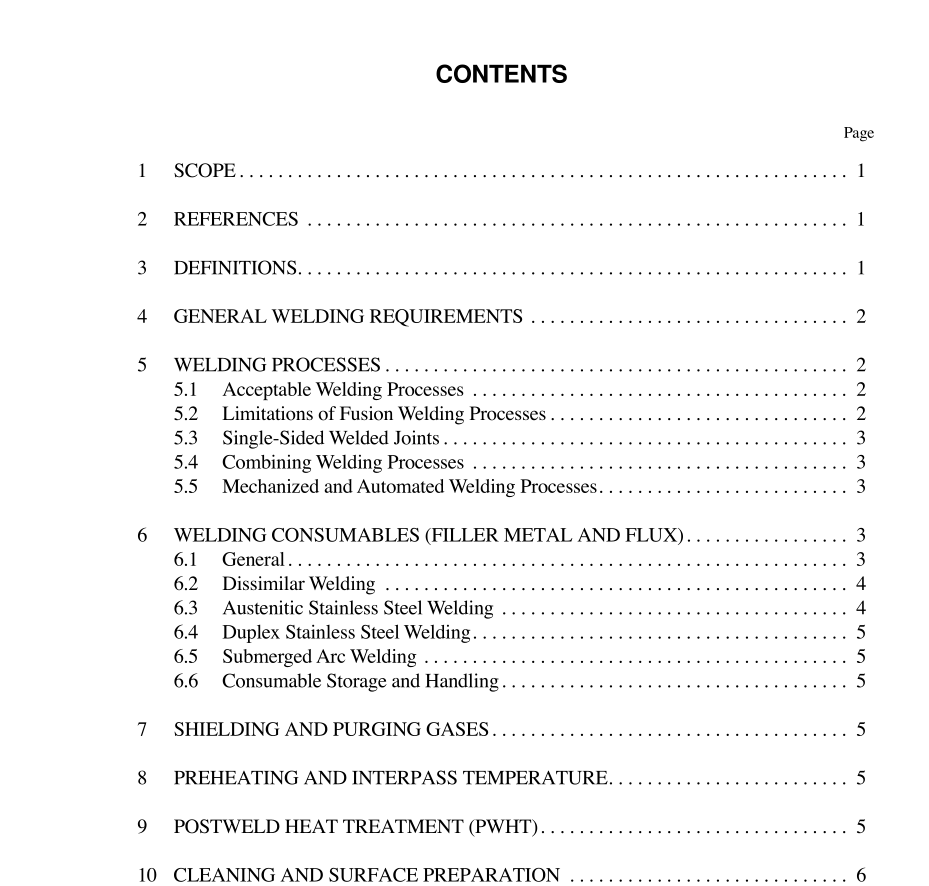API ST 582 pdf download

API ST 582 pdf download.Welding Guidelines for the Chemical, Oil, and Gas Industries
1 Scope
1.1 This recommended practice, initiated and developed through the joint efforts of API and Process Industry Practices (PIP), provides supplementary guidelines and practices for welding and welding-related topics for shop and Þeld fabrica- tion, repair and modiÞcation of: a. Pressure-containing equipment (such as pressure vessels, heat exchangers, tankage, piping, heater tubes, pressure boundaries of rotating equipment, and attachments welded thereto). b. Non-removable internals for pressure vessels. c. Structural items attached and related to process equipment. d. Any other equipment or component item when referenced by an applicable purchase document. 1.2 This document is general in nature and is intended to augment the welding requirements of ASME Section IX and similar codes, standards and practices such as those listed in Section 2. The intent of this document is to be inclusive of chemical, oil and gas industry standards, although there are many areas not covered, e.g., pipeline welding and offshore structural welding. 1.3 This document is based on industry experience and any restrictions or limitations may be waived or augmented by the purchaser.
3 Definitions
3.1 applicable code: The code or standard speciÞed by the purchaser to which the equipment shall conform. 3.2 inspector: PurchaserÕs representative. 3.3 procedure qualification record (PQR): A record of welding variables used to produce an acceptable test weld- ment and the results of tests conducted on the weldment to qualify a welding procedure speciÞcation. 3.4 purchaser: The party that issues the purchase order. This may be the user or owner of the equipment or compo- nent, or the purchaserÕs designated agent (e.g., engineering contractor).
5 Welding Processes
Commentary : The need to specify the make and model, program, equipment settings and pulse waveform is based upon the effects these variables have on welding arc perfor- mance, especially sidewall fusion and out-of-position weld- ing. Studies have shown considerable variation in arc characteristics when one make or model of welding system is compared to another. This variation can lead to welding defects, some of which may be very difÞcult to detect by radiography. 5.2.2 Short Circuiting Gas Metal Arc Welding (GMAW-S) The use of GMAW-S shall be limited to the following conditions: a. The process shall not be used for branch connections or socket welds. b. For vertical welding, the root pass and second pass pro- gression for a material of any thickness may be either uphill or downhill. c. The Þll and cap pass for butt or Þllet welds may be welded with this process provided the thickness of any member does not exceed 3 / 8 in. (9.5 mm) and vertical welding is performed with uphill progression. 5.2.3 Pulsed Gas Metal Arc Welding (GMAW-P) GMAW-P may be used for any material thickness in any position. Commentary : Whenever the welding system is changed or the settings on existing equipment signiÞcantly altered, the fabricator should verify weld properties. The extent of veriÞ- cation or testing should be as agreed between the purchaser and fabricator. 5.2.4 Flux Cored Arc Welding (FCAW) 5.2.4.1 Self-shielding FCAW (FCAW-S) may be used only for welding carbon steel structural items. The following guidelines and restrictions apply: a. Electrode types identiÞed by the consumable manufac- turer for multipass application should be used. b. Only electrode classiÞcations which have speciÞed mini- mum impact test requirements should be used. c. FCAW-S shall not be used with other welding processes without qualifying the speciÞc combination.









